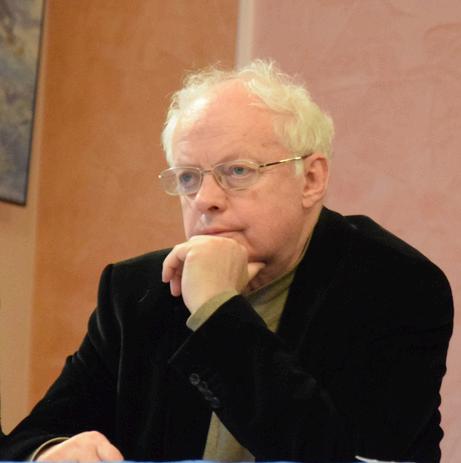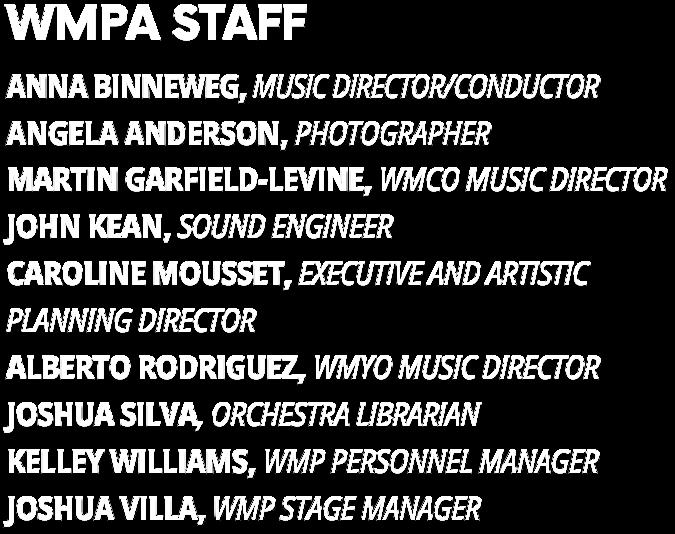




















Greetings, and welcome to the continuation of WashMetPhil’s 53rd concert season! It is with honor and duty that we continue to demonstrate our commitment to the power of unity through the spirit of human connection and live music within our community.
Today’s program is a poignant exploration of human conflict and resolution. "War and Peace" delves into the depths of wonder and emotion with a program that juxtaposes turbulence with tranquility. Augusta Holmés' evocative "Irlande" sets a contemplative mood, reflecting on the complexities of national identity and struggle. Myroslav Skoryk's Piano Concerto No. 3, (featuring Ukrainian-American pianist Stanislav Khristenko), offers a powerful testament to resilience and hope amid great strife and adversity. Concluding the program with a timeless masterpiece, Beethoven's iconic Fifth Symphony delivers a cathartic journey from darkness to triumph, that will leave us with a sense of profound reflection, hope and renewal.
WMPA’s purpose is to unite and uplift our community through orchestral music – we hope today’s concert is no exception!
Remember to join us for our post-concert celebration, AfterChats with Anna And from all of us here at WMPA, we wish you and your loved ones, a peaceful spring season!



AfterChats with Anna are relaxed, post-concert conversations with Music Director Anna Binneweg, moderated by Executive and Artistic Planning Director Caroline Mousset, and featuring our guest artists. Grab a glass of bubbly, bring your questions, and join us for these engaging sessions! You'll gain insight into the music you've just experienced and have the chance to meet the artists. Bestofall, AfterChatsarefreeforallticketholders.
AUGUSTAHOLMÉS
Irlande
MYROSLAVSKORYK
PianoConcertoNo.3
Prayer
Dream
Life
Scherzo.Allegro PROGRAM

—Intermission—
LUDWIGVANBEETHOVEN
SymphonyNo.5in
Allegroconbrio Andanteconmoto
TheDancingMoonlight –AugustaHolmés
BornDecember16,1847,inParis,France
DiedJanuary28,1903,inParis,France
This work was premiered in November of 1882 by ÉdouardColonne.Itisscoredforpiccolo,twoflutes,two oboes,Englishhorn,twoclarinets,fourbassoons,four horns, two trumpets, two cornets, three trombones, tuba,timpani,percussion,twoharps,andstrings

Augusta Mary Anne Holmès was born in Paris to an Irish father, Charles Dalkeith Holmes (without the accent), who had fought at Waterloo After the war, he settled in France and married Tryphina Shearer. Their daughter Augusta was a talented pianist who was not permitted to study at the Paris Conservatory because she was a woman but eventually took lessons with Hyacinthe Klosé and César Franck. Because of the convention at the time, her early works were published under a male name, Hermann Zenta Once she gained some notoriety, she reverted to her real name.
As a composer, she wrote three operas, about a dozen cantatas, orchestra works, chamber music, piano pieces, and art songs. Holmès composed several large orchestral works. Among
these were Ode triumphale that included 1200 musicians and was written for the 1889 Exposition Universelle to celebrate the centenary of the French Revolution. She also composed a work to reflect the uprising in Poland
Perhaps her most famous work today completely characteristic of her vaguely Wagnerian style is her symphonic poem Irlande, which paints a vivid picture of the beauty of the Emerald Isle but also includes a recognition of Irish hardship and strife. The work opens with a long cadenza for solo clarinet. Soon the orchestra enters at an allegro tempo with murmurs in the bassoons and lower strings that evolve into a lively Irish dance for full orchestra. The second theme is lyrical with jig-like triplets in the woodwinds. An andante funeral march appears in the cellos and is soon taken over by most of the orchestra. After a transition that crescendos to an expected climax, everything becomes pianissimo, and an English horn solo appears Holmès then switches to a fast and frantic allegro and returns to bassoon and cello configuration with triplets in the woodwinds A series of ominous diminished chords leads to the brassy grand climax for full orchestra in the form of a triumphal march.
Born July 13, 1938, in Lwów, Second Polish Rep (now Lviv, Ukraine)
Died June 1, 2020, in Kyiv, Ukraine
This work was composed in 1965 and is based on his 1964 sc the film Shadows of the Forgotten Ancestors It is scored f piano, two flutes, two oboes, two clarinets, two bassoon horns, three trumpets, two trombones, bass trombone, timpani, percussion, and strings

Myroslav Skoryk was a product of his time. Born to a historian father and chemist mother, he heard music around the house, but he was the only one who would receive formal music training. Although he started lessons at the Lviv Music School at the age of 7, it all stopped two years later when his family was deported to the work camps of Siberia.
Once they were released ten years later in 1955, Skoryk entered the Lviv Conservatory. After graduating, he went to the Moscow Conservatory for advanced studies with composer Dmitri Kabalevsky Once he left Moscow in 1964, he accepted a position as lecturer at the Kyiv Conservatory where he remained until 1988. After a three-year stint in Australia from 1996-1999, he became artistic director of the Kyiv Opera As a composer, Skoryk wrote orchestral pieces, film music, sacred works, chamber music, operas, secular choral works, concertos, and art songs
Skoryk’s 1965 Piano Concerto No 3 is based on his 1964 score for the film Shadows of the Forgotten Ancestors. The harmonic language is dissonant in a dramatic context. His melodies are evocative of the drama played out on screen
The first movement, Prayer, opens with the soloist playing a dissonant chorale, which is soon joined by the winds This gives way to the strings and their introduction of the jagged first theme, which is played by the soloist after a few measures. The second theme is slower but angsty. Repeated patterns in the strings build to an impressive climax before more placid meditative music takes over. This is dispelled by a full orchestra entrance, which quickly returns to the opening music, now including the orchestra but still led by the soloist. An overwhelming climax leads to the final three chords in the piano
Skoryk’s second movement, Dream, is similar in character to the first Chopinesque ornaments are heard, as well as masterful orchestration, especially in the strings.
The finale, Life, is reminiscent of Shostakovich’s scherzos with rapid runs and dissonant punctuations. However, this music is not derivative in any way, as Skoryk’s musical language is quite unique The piano writing is difficult to play, but the puckish and angular orchestration gives it an attractive quality. Skoryks coda is masterful an ostinato sounds like a heartbeat and, as it becomes quieter, the opening chorale appears to end the work
BornDecember16,1770,inBonn,Germany
DiedMarch26,1827,inVienna,Austria
TheworkwaspremieredonDecember22,1808,atthe TheateranderWieninViennawithBeethovenconducting. Itisscoredforpairsofwoodwindswithaddedpiccoloand contrabassoon,twohorns,twotrumpets,threetrombones, timpani,andstrings

The mammoth concert at which the Fifth Symphony was first heard was held at Vienna's Theater an der Wien on December 22, 1808 At least three hours in duration, the event was an important one for Beethoven with world premieres of the Fifth and Sixth Symphonies, the Choral Fantasy, and the Fourth Piano Concerto. Viennese premieres of sections of the Mass in C, the dramatic concert aria Ah! Perfido, and a piano improvisation by the composer filled out the program. However, Beethoven’s torturous personal journey to write the work is the stuff of legend.
The town of Heiligenstadt, now a Vienna suburb, was a small country village in Beethoven's day. It was here that he escaped a life of publishing deadlines and the many visitors who distracted him from composition. Heiligenstadt allowed him to work uninterrupted. In 1802 Beethoven spent the summer there while sorting out a much more serious problem. Recognizing his worsening deafness, he reached an emotional turning point where he resolved that either his life had to end in misery or continue with renewed resolve. He wrote a letter to his brothers explaining his plight The "Heiligenstadt Testament" as it has become known, outlines Beethoven's depression over his deafness, reading much like a suicide note.
"How could I possibly admit an infirmity in the one sense which ought to be more perfect in me than others..."
BeethovenfoundsolaceatHeiligenstadt,returningtherequiteoften,includingthesummersof 1807and1808. DuringthosetwosummershecompletedtheFifthandSixthSymphoniesand twopianotrios. Hishappiestmomentswerespentrevelingintherurallocaleandallowinghis pentoflow. SomeofthemoreplacidmomentsundoubtedlyfoundtheirwayintothePastoral Symphony–aworkinfivemovements,eachofwhichdepictsasceneinthecountry. Forthe FifthSymphony,Beethovenapparentlydrewuponhismoredepressiveepisodesandaheroic resolvetoovercometheHerculeanchallengesthatwouldultimatelyfaceadeafcomposer.
PerhapsthemostfamiliarfournotesinmusicopentheFifthSymphony–threeshortGsanda longerE-flat. ThisrhythmwasadoptedlaterastheMorsecoderepresentationoftheletterV, which,standingfor“victory,”ledtoitsuseinWorldWarIIBritainasamusicalmotiftorepresent thatferventdesiretodefeattheGermanmilitary. Morepertinenttoourpurposes,thisrhythmic pervadestheentirefirstmovement. Infact,theremainderoftheworkreliesheavilyuponthe samerhythmicpattern.
Beethoven’slyricalsecondmovementiscastindoublevariationform. Thesimplesonglikefirst themeistransformedintoanobleandmajesticpaean. Alsobuiltfromthefour-notemotif,the scherzoisweightyandponderous,withadistinctairofunswervingresolve. Thetriosection, suddenlytransformedintoCmajor,reliesheavilyuponthelowerstringsinuncharacteristically briskpassages.
Withabriefandmysteriousminor-keytransition,Beethovenpropelstheorchestraheadfirstinto theheroicfinale Thisbrilliantoutburst,backinCmajor,includesthethreetrombones,piccolo, andcontrabassoonforthefirsttime,givinganintoxicatingrichnesstothetimbre However,the scherzothemereturnsjustasthedevelopmentsectionends,effectivelyslowingthedramatic paceofthework Beethovenonceagaintransitionsbacktothefinaletheme,thistimemore grandiosethanbefore Justwhenthesymphonyseemstobecomplete,alengthycodapushes forwardatbreakneckspeedtoafinalblazeofglory
©2025OrpheusMusicProse&CraigDoolin wwworpheusnotescom

Described as a “poet of piano” by Le Soir (Belgium), Ukrainian-born American pianist STANISLAV KHRISTENKO has performed in someoftheworld’smajorconcerthalls.Hehas been praised for “emotional intensity”, “charismaticexpression”,“palletteoftouches”, “solid”and“precisetechnique”byTheNewYork Times,TheWashingtonPostandMiamiHerald, TheGramophoneandBBCMusicMagazineand ElPaís Khristenkohasappearedasapiano soloistwiththeClevelandOrchestra,National OrchestraofBelgium,PhoenixSymphony,Liege RoyalPhilharmonic,SuwonPhilharmonic

Orchestra,aswellasBilbao,Madrid,Tenerife,PuertoRico,Richmondsymphonyorchestras, amongothers.HisperformancehighlightsincludesolorecitalsatCarnegieHall,Vienna Konzerthaus,PalaisdeBeaux-ArtsinBrussels,aswellasperformanceswithorchestrasinThe BerlinPhilharmonie,SeoulArtsCenter,PragueRudolfinum,MoscowConservatoryGreatHall, amongothers.Khristenko’sperformanceasapianosoloistwithTheLvivNationalOrchestraof UkraineinSternAuditoriumatCarnegieHallhasbeenchosenasoneof15highlightsofthe 2022/2023CarnegieHallseasonbyTheNewYorkTimes.
HisrecordingswerereleasedonSteinway&Sonslabel(“Fantasies”,“RomeoandJuliet”),Naxos (“SolerSonatas”),Oehms(“Krenek:PianoWorks”),andToccataClassics(“ErnstKrenekPiano Works:VolumeOne”,“ErnstKrenekPianoWorks:VolumeTwo”).HeisaSteinwaySpirioArtist withasignificantrecordingpresenceintheSpiriorecordingcatalogue KhristenkoisaprizewinnerofnumerouspianocompetitionsincludingGoldMedalatCleveland PianoCompetition,FirstPrizeatMariaCanalsPianoCompetition,SecondPrizesatIsangYun andTakamatsuPianoCompetitions,andFourthPrizeatQueenElisabethMusicCompetition.In theUnitedStates,healsoreceivedFirstPrizesatBosendorfer,JoseIturbi,VirginiaWaring,and WidemanCompetitions,amongothersHehasbeenonthejurypanelofmanyinternational pianocompetitions.
InhishometowninUkraine,Khristenkoco-foundedmusicfestivalKharkivMusicFestthat presentedworld’stopclassicalmusiciansaswellasuniqueprojectsincludingFestival Orchestra,classicalmusicconference,Children’sOrchestra,artist-designedpianosfor interactivepublicdisplay.AsaMusicDirector,hefoundedNovaSinfoniettaChamberOrchestra ofUkrainethatperformedworksofover40composersinitsfirstthreeseasons. KhristenkogavehisfirstpianosolorecitalinKharkivPhilharmonicHallattheageof11.He graduatedfromMoscowChopinCollegeandMoscowTchaikovskyConservatory,wherehe studiedwithVeraGornostaevaIn2008,hemovedtotheUnitedStatestostudywithSergei BabayanattheClevelandInstituteofMusic.HealsocompletedPostgraduateArtisticTrainingin OrchestralConductingatTheChopinUniversityinWarsaw,PolandandShortCoursein OrchestralConductingatTheRoyalNorthernCollegeofMusicinManchester,England StanislavKhristenkoisaSteinwayArtist.

As Music Director of the Washington Metropolitan Philharmonic, Music Director/ Conductor of the Londontowne Symphony Orchestra, the AACC Symphony Orchestra at Anne Arundel Community College, and a frequent guest conductor on the national and international scene, ANNA BINNEWEG repeatedly captures audiences with her enthusiasm and passion for music. Putting her musicians, not herself, in the spotlight, Binneweg brings out the best in them Her orchestras’ shared focus and energy makes orchestral music sound new, fresh and exciting. Her programs and performances are alluring, engaging and attract diverse audiences of all ages, particularly making classical repertoire more appealing to younger generations. Over the course of her career, Binneweg has performed in some of the nation’s most reputable concert venues including the Kennedy Center’s Concert Hall, Meyerhoff Symphony Hall, and the Walt Disney Concert Hall Her international conducting experiences include tours to Austria, Spain and debut appearances with the Chernihiv Philharmonic (Ukraine), Lviv Virtuosi (Ukraine) and the Minsk Conservatory Orchestra (Belarus). A committed music educator, Binneweg’s youth orchestra experience includes appointments with the Houston Youth Symphony (Houston, TX) and the San Luis Obispo Youth Symphony, in addition to her guest conducting appearances with colleges and universities throughout the United States She is in frequent demand as an orchestra clinician and adjudicator throughout the Mid-Atlantic region and served on the national executive board of directors for the College Orchestra Directors Association (CODA) from 2014-2018 Binneweg has worked with conductors such as Leonard Slatkin, Daniel Barenboim, Robert Spano, James Paul, Michael Morgan, Duaine Wolfe, Nurhan Arman and David Effron through various engagements sponsored by the League of American Orchestras, the Conductors Institute of New York and the Royal Conservatory of Music in Toronto. Most recently, she was elected to the board of directors of the International Conductors Guild (2021) Earning a doctorate degree of music in orchestral conducting from Northwestern University where she studied with Victor Yampolsky, Binneweg has also served on the conducting faculties at Loyola University, the Sherwood Conservatory of Music, and American University.Like all conductors, Binneweg is the most visible part of the orchestra, the advocate and face of the ensembles she leads. As an active conductor of the 2022-2023 season, she remains committed to reigniting her community’s passion for live music and collaboration during these pandemic times.Binneweg is the recipient of the 2015 Annie Award for the Performing Arts awarded by the Arts Council of Anne Arundel County. www.annabinneweg.com
VIOLIN I
Timothy Kidder, Concertmaster
Sophie Bouwsma
Rosan Choi
Erin Flynn
Perry Francis
Sophia Hoagland
Joe Keum
James Ling
Lynn Rovelli
Cheryl Stickley
VIOLIN II
Slavica Ilic, Principal
Anne Anderson
Rebecca Edelstein
Lynn Mueller
Claire Randall
Jane Thell
Marisa Wright
Hannah Villa
VIOLAS
Howard Vandersluis, Principal
Sharon Bingham Wolfolk, Assistant Principal
Claire Bradfuhrer
Tate Commission
Kevin Kirby
Dennis Murphy
Isaiah Reed
CELLOS
Samuel Runolfson, Principal
David Bates
Alex Cooper
Alix Gates
Soren Johnson
John Matzner
Amy Medearis
Melinda Ward
BASSES
Robyn Ambrose, Principal
Scott Freeman
Greg Ondo
FLUTES
Crystal Lee, Principal
Julia Amadee
Chris Kowalewski
OBOES
Laurel Kuxhaus, Principal
Janet Renze
Alicia McMahan, English horn
CLARINETS
Brittany Pemberton, Principal
Chris Epinger
BASSOONS
Walter Wynn III, Principal
Hillary Burchuk
Robert Goler
HORNS
Bernard Baiden, Principal
Wendy Chinn
Aaron Meitz
Jon Ohmart
TRUMPETS
Josh Silva, Principal
J B Greear
Andy Schuller
TROMBONES
Bryan Bourne, Principal
Robb McDonald
Chris Thackery
TUBA
Karl Hovey
TIMPANI
Bruce Davies
PERCUSSION
Randy Eyles, Principal
Julie Choi
Glenn Paulson
HARP
Wendy Willis
* Local Business Partner
** Washington Metropolitan Philharmonic musician
^ The Ulysses James Legacy Fund
WMPAwouldliketoexpressitswarmestgratitudetoourgrowingfamilyofdonorswhohavehave demonstratedacommitmenttotheperformingartsandimprovingourcommunity.Thefollowingreflects giftsreceivedfromFebruary19,2024throughFebruary19,2025.FriendlevelshonorAmericancomposers whoseworksfeatureinourconcerts.
SAMUEL BARBER $10,000+
Margaret M Ballard
Galena-Yorktown Foundation
Ries Family
Gordon & Sheila Soper
FLORENCE PRICE $5,000-$9,999
Gary & Phoebe Mallard
Warren Zwicky
JENNIFER HIGDON $2,500-$4,999
Helenmarie Anderson Corcoran
Edward Farren
Donna J Reuss
Margaret Ann Roddy
Nancy West In honor of John C West and Alan B Prosise, Jr
AARON COPLAND $1,000-$2,499
Angela Stover Anderson^
Samuel & Patricia Boglio
Bruce Davies**
Karl Hovey** In honor of Ul James
John Kean^
William McDaniel
Robb McDonald** and Brittany
Pemberton**
Pediatric Associates of Alexandria* In honor of WMPA Youth Orchestras
Deidre Pistochini
Carole A. Pyle^
Mr. David C. Schwark & Mrs. Suzanne C. Schwark
WILLIAM GRANT STILL $500-$999
Anonymous
Anna Binneweg**
Gary Bravy
Rachel Colombana
Sarah & Michael Fredell
Inés Garcia
Thomas Helsinki
Kimberly & Rob Humphries
Joseph Keum**
J. Kunz
Mitchell McCorcle^
Dennis Murphy**
Jennifer Ngai Lavallee
Julie Pangelinan**
Mary Reed
Ralph & Nancy Schuetz
Phillip & Eileen Thompson
Patricia Williamson
LIBBY LARSEN $250-$499
Grazina Blekaitis^
Thomas Boudreau
Marguerite Chadwick
Julie Geshunskaya
David Jourdan In memory of
Kathleen Jourdan
Kirby Family
John Reiser
Nancy Sage
Cheryl Stickley**
REBECCA CLARKE $100-$249
Reinaldo Luis Andujar
Susan Bairstow
Sanja Basaric
Suzana Basaric-Ilić In honor of Slavica
Ilić**
Vanja Basaric
David Bell
Mason Botts
Carter Bryan, II
Lorrie Brown
Hillary Burchuk**
Carol Burke
Jessica Burmester^
Adrienne Cannon
Joseph H. Coleman, Jr.
Marcia Crockett In honor of Ulysses
James
Richard Darilek
Kristin Dillon
Kevin & Sharon Dooley^
Shannon M. Dubicki^
John Sutherland Earle In honor of
Ulysses James
Rebecca Edelstein**
Christopher Epinger** In honor of
Frank Joseph Epinger
Kathleen Farrell
Richard & Kathleen Fonda
Sallie Forman
Melissa Franger
Gay Gardner^
Alix Gates**
Robert Goler^
Carol Goodloe
Roger Gram
Kay & David Green
Julia Greenway
Phyllis Gron
June Hajjar^
Margaret Harrison
Gary & Christel Hignett^
Ann Houpt
Jane Hughes** & William Jokela
Anthony Iannaccone In honor of
Ulysses James
Noel Kaupinen
Carol Anne Kelly
Anne Kisthardt
Elizabeth Kluegel-Niblock In memory of Daena Kluegel
Crystal Lee**
Kathleen Litchfield
Barbara R Lowrey
John Matzner**
Laura Maynard
Carol & Robert McGinnis
Marlene McHugh
Amy Medearis**
Martin Menez
Robert Mikulak
James Moody^
H. Paul Moon
Lisa Motley
Thomas Nichols & Virginia Keeley
Joanne Parker-Braxton
George H. Parks
Kristen Race
Bill Rojas
Melissa Roy
Elsy Salas In honor of Caroline Mousset
William K Schultz
Richard Shea
Greg & Chelsey Simpson
Joan & Irwin Singer
Lee Smith
Virginia Thackery In honor of Chris Thackery**
Stu & Ruth Tucker
Melinda Ward**
Gayle & Joe White^
Sheri & Raymond Wolfe
Program funding provided by our donors, and in part by:






Washington Metropolitan Philharmonic: an adult orchestra for local professional, semi professional, and dedicated amateur musicians
Washington Metropolitan Youth Orchestra: an inclusive youth orchestra for grades 9-12
Washington Metropolitan Concert Orchestra: a beginner’s orchestra for grades 6-9
Lyceum Chamber Series: a summer series of weekly chamber music concerts at the Alexandria History Museum at the Lyceum
Bilingual Family Concerts: Bilingual narration concert programs presented in underserved communities featuring members of the Washington Metropolitan Philharmonic
WMPA’s PURPOSE is to unite and uplift our community through classical music. Our VISION is to create the audience of the future for classical music
Our MISSION is to provide programs to:
Educate and engage students through our Youth Orchestras
Perform and promote orchestral music through the Washington Metropolitan Philharmonic
Connect and communicate chamber music through our summer Lyceum Series
Expand and enlighten newcomers to classical music through our Bilingual Family Concerts





